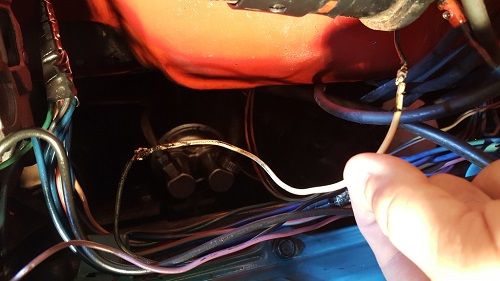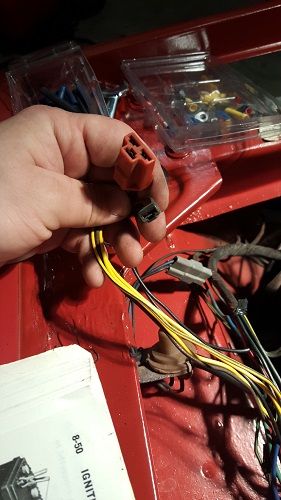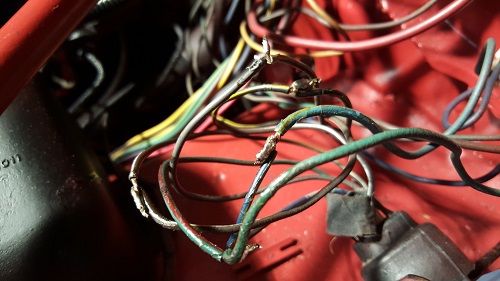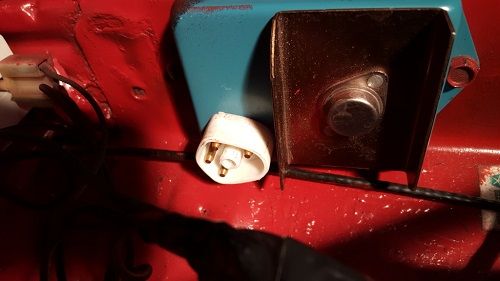SwingerLSX75
Well-Known Member
OK guys I had this over in the slant 6 section on one of my previous help threads but figured since its an ignition/electrical issue this would be the place to put it.
Problem is I'm getting no spark anymore(after having run just fine), I initially started troubleshooting because it would randomly shutoff while idling. Then it began not starting up anymore either. I noticed there wasn't enough power coming out of the ignition so I replaced the ignition switch.
I am measuring 5.1V at the positive lead on the coil with the engine off and the key in the "on" position, and checked and reset the air gap with a brass feeler just like it said to use in the manual. From what I understand normally you will have between 7-10 volts at the positive terminal on the coil with the key in the on position. Am i right?
After looking through the diagram in the manual and it showing where the wires run and everything I began basically unwrapping all the electric tape that was covering the ignition system and that's where the fun began. First I found this(pay close attention to the blue wire in the middle of the picture) about 8" down the wire after it leaves the firewall connection.
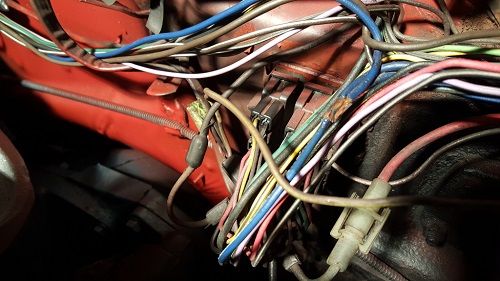
I'm not old enough to have been born when these cars were made but does that look like something a new factory car would have? I traced out the blue wires one ran to the ballast resistor, one ran up the drives side to the little vacuum thing( cant remember the name of it right now)
http://s450.photobucket.com/user/DDGDSM/media/The Dart/20150617_202121_zpsreubm3ms.jpg.html
and then the other went to the passenger side where I found this, yet another splicing together of this one blue wire into 3 other blue wires. The other 3 look to lead to the 3 electronic boxes on the passenger side fender well. Yet again not something I thought id be seeing from a factory harness. So I am in full wtf mode at this point.

After seeing this I measured the voltage with the key in the on position and it still reads 11-12v like it should.
I went back and looked at the bottom right connection on the ballast resistor that is supposed to be the feed for the coil + terminal was a brown wire. So I traced the brown wire over to the passenger side of the bay and began peeling back the electrical tape to see if there were any issues with the brown wire. Then I fine a cluster **** after I get the tape off where it has two exposed wire sections essentially just hand twisted together and wrapped in electrical tape. Had to take a break at this point because I was a little pissed that one of the previous owners had thought this was sufficient. After cutting the wire to clean it up I noticed a considerable size difference in the two wires. So I began tracing again and it led me here
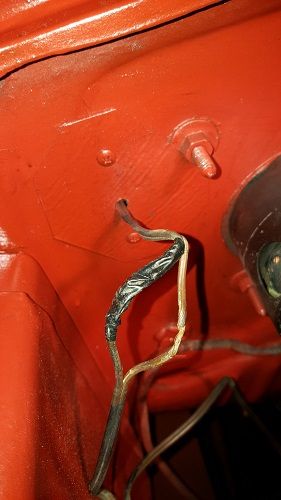
where it goes into the firewall and then comes back out and connects to the positive terminal on the coil( you could see why I was upset). Then it registered someone had the damn positive coil wire running to something inside the car and then back out to connect to the coil. So part of reason I'm not getting enough voltage to the + terminal on the coil is because they had rerouted the brown wire carrying the coil + voltage to something under the passenger side dash and then had a much smaller gauge wire come back out and connected to the coil's + terminal. It got a little late and by the time I got off the phone with the original owners of the car, it was too late for me to keep messing with it. But come to find out the original owner had installed a fuel cutoff switch under the dash on the glove box side and thought tapping into that wire for 12v power would be best.
Problem is I'm getting no spark anymore(after having run just fine), I initially started troubleshooting because it would randomly shutoff while idling. Then it began not starting up anymore either. I noticed there wasn't enough power coming out of the ignition so I replaced the ignition switch.
I am measuring 5.1V at the positive lead on the coil with the engine off and the key in the "on" position, and checked and reset the air gap with a brass feeler just like it said to use in the manual. From what I understand normally you will have between 7-10 volts at the positive terminal on the coil with the key in the on position. Am i right?
After looking through the diagram in the manual and it showing where the wires run and everything I began basically unwrapping all the electric tape that was covering the ignition system and that's where the fun began. First I found this(pay close attention to the blue wire in the middle of the picture) about 8" down the wire after it leaves the firewall connection.

I'm not old enough to have been born when these cars were made but does that look like something a new factory car would have? I traced out the blue wires one ran to the ballast resistor, one ran up the drives side to the little vacuum thing( cant remember the name of it right now)
http://s450.photobucket.com/user/DDGDSM/media/The Dart/20150617_202121_zpsreubm3ms.jpg.html

and then the other went to the passenger side where I found this, yet another splicing together of this one blue wire into 3 other blue wires. The other 3 look to lead to the 3 electronic boxes on the passenger side fender well. Yet again not something I thought id be seeing from a factory harness. So I am in full wtf mode at this point.

After seeing this I measured the voltage with the key in the on position and it still reads 11-12v like it should.
I went back and looked at the bottom right connection on the ballast resistor that is supposed to be the feed for the coil + terminal was a brown wire. So I traced the brown wire over to the passenger side of the bay and began peeling back the electrical tape to see if there were any issues with the brown wire. Then I fine a cluster **** after I get the tape off where it has two exposed wire sections essentially just hand twisted together and wrapped in electrical tape. Had to take a break at this point because I was a little pissed that one of the previous owners had thought this was sufficient. After cutting the wire to clean it up I noticed a considerable size difference in the two wires. So I began tracing again and it led me here

where it goes into the firewall and then comes back out and connects to the positive terminal on the coil( you could see why I was upset). Then it registered someone had the damn positive coil wire running to something inside the car and then back out to connect to the coil. So part of reason I'm not getting enough voltage to the + terminal on the coil is because they had rerouted the brown wire carrying the coil + voltage to something under the passenger side dash and then had a much smaller gauge wire come back out and connected to the coil's + terminal. It got a little late and by the time I got off the phone with the original owners of the car, it was too late for me to keep messing with it. But come to find out the original owner had installed a fuel cutoff switch under the dash on the glove box side and thought tapping into that wire for 12v power would be best.

